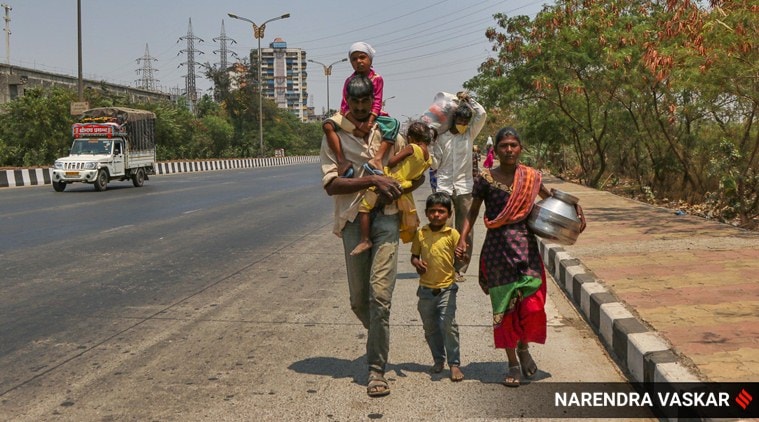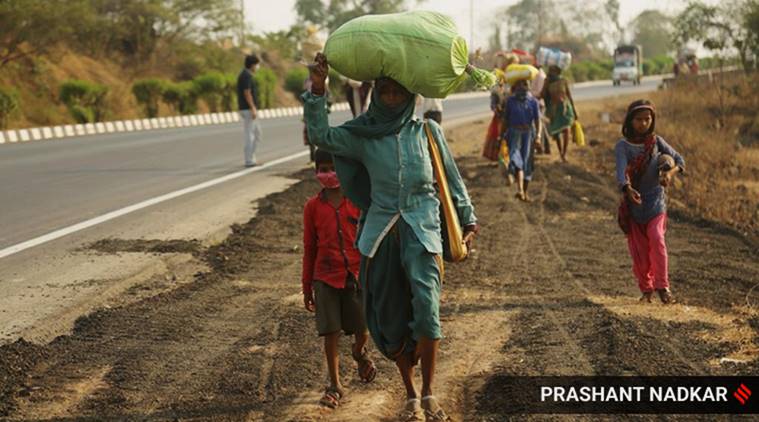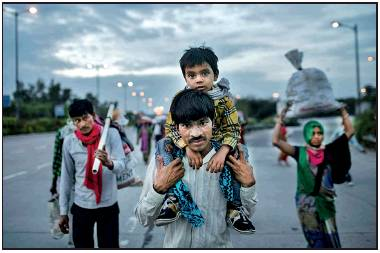The impact of the lockdown may make social issues more prominent again in terms of class, at the expense of caste as well as religious identities and communal tendencies.
Written by Christophe Jaffrelot , Haider Abbas Rizvi | Published: April 21, 2020

The BJP attracted poor voters in large numbers during the last Lok Sabha elections, especially among the Dalits.
When interviewed by journalists, several migrant workers badly affected by the COVID-19-related lockdown admitted that they had voted for the BJP in 2019. Indeed, the party attracted poor voters in large numbers during the last Lok Sabha elections, especially among the Dalits.
This is puzzling, as BJP used to be associated with upper-caste, middle-class voters, but this is not new. According to the National Election Survey of Lokniti-CSDS that has been published in the last issue of Studies in Indian Politics, the BJP attracted a record number of Dalit voters in Uttar Pradesh during the 2019 Lok Sabha elections – not only that but the poorer they were, the more BJP-oriented these Dalit voters seemed to be.
Table 1: The 2009, 2014 and 2019 LS Elections: The Dalit vote by class
| Class | Cong. | BJP | BSP | ||||||
| 2019 | 2014 | 2009 | 2019 | 2014 | 2009 | 2019 | 2014 | 2009 | |
| Lower | 22 | 17 | 31 | 32 | 22 | 13 | 10 | 13 | 20 |
| Middle | 26 | 18 | 34 | 27 | 22 | 16 | 8 | 14 | 14 |
| Rich | 24 | 20 | 35 | 30.5 | 27 | 19 | 4 | 13 | 14 |
(Source: C. Jaffrelot, “Class and Caste in the 2019 Indian Election–Why Do So Many Poor Have Started to Vote for Modi?”, SIP, 2019)
This counterintuitive state of things can be explained in different ways. First, some Dalits have been attracted, like others, by Hindutva and the ethno-nationalist discourse of Prime Minister Narendra Modi during the election campaign, especially when it gained an anti-Pakistani overtone in the wake of the Pulwama terrorist attack. Second, some Dalit jatis which had never been sensitive to Ambedkarism have continued to follow the sanskritisation path, like the Valmikis, for instance. Third, these groups, as well as others, have benefited from the social work of the subsidiaries of the Sangh Parivar, including Sewa Bharati which has been giving free education and free health treatment in slums. Four, the poorest among the Dalits have been wooed by Centrally-sponsored social schemes like the Ujjwala Yojana, Jan Dhan Yojana, and Pradhan Mantri Awas Yojana, even when they have not benefited from them, but thought they would because of their trust in Modi. In addition to all these explanations, one also needs to factor in caste at the jati level.
Table 2: The Jatav and non-Jatav Dalit votes in UP (2019 Lok Sabha election)
| Class | Caste | Congress | BJP | MGB | Other |
| Poor | Jatav/Chamar | 0 | 11.6 | 79.8 | 8.5 |
| Non-Jatav SC | 2.3 | 45.3 | 45.3 | 7 | |
| Lower | Jatav/Chamar | 1.1 | 18.9 | 70.5 | 9.5 |
| Non-Jatav SC | 11.1 | 50.8 | 33.3 | 4.8 | |
| Middle | Jatav/Chamar | 4.4 | 15.6 | 71.1 | 8.9 |
| Non Jatav SC | 10 | 10 | 60 | 20 | |
| Rich | Jatav/Chamar | 0 | 62.5 | 37.5 | 0 |
| Non Jatav SC | 0 | 66.7 | 33.3 | 0 | |
| Total | Jatav/Chamar | 1.1 | 16.2 | 74 | 8.7 |
| Non Jatav SC | 6.2 | 45.7 | 41.4 | 6.8 |
(Source: Lokniti-CSDS, National Election Survey, 2019)
The BJP, in fact, has not received votes coming from all the Dalit jatis, but mostly those coming from the non-Jatavs/Chamar SCs. While Jatavs/Chamars continue to support the BSP (74 per cent of them did so in the Lok Sabha elections), almost 46 per cent of the non-Jatavs/Chamars voted for the BJP. And, interestingly, the poor, among them, were especially supportive. Why? Primarily because the BJP nominated non-Jatavs/Chamars in the reserved constituencies of Uttar Pradesh: The SPINPER (Social Profile of India’s National and Provincial Elected Representatives) data set that Ashoka University and Sciences Po are building show that the BSP has given more than 20 per cent of its tickets to Jatavs, whereas the BJP has nominated only 5 per cent of Jatavs, 7.7 per cent of Pasis and 9 per cent of “Other SCs”. But why have these SC politicians fought the BSP which claimed that it was the Dalit party of UP? Largely because it is seen as a Jatav/Chamar party and because non-Jatavs/Chamars resent the rise to power of this caste group.
Indeed, when the BSP does well electorally during state elections, the Jatav/Chamar MLAs are found in large numbers in the Vidhan Sabha: In 2007, they represented almost 60 per cent of the Dalit MLAs. Not only did they tend to dominate the SC seats, but they also cornered a large proportion of the job quotas: According to the last round of the Indian Human Development Survey (2011-12), more than 10 per cent of Jatavs had a salaried job in 2011-12, against 6.6 per cent of the Pasis and 4.5 per cent of the Dhobis. Similarly, they are well represented in the universities of Uttar Pradesh and, as a result, 2.5 per cent of them were graduates in 2011-12, when graduates represented only 0.5 per cent of the Pasis and 0.6 per cent of the Dhobis.
The growing support of the Dalits for the BJP is, therefore, one of the paradoxical results of reservations which has increased inequalities amongst the SCs, making it easier for the BJP to co-opt Dalit jatis who resented the rise of the dominant ones. Interestingly, the non-Jatav/Chamar BJP voters came in large numbers from the poor of these jatis.

The BJP, in fact, has not received votes coming from all the Dalit jatis, but mostly those coming from the non-Jatavs/Chamar SCs. (Representational)
A similar situation prevails outside of UP. In Maharashtra, for instance, the caste group which has traditionally benefited from reservations, the Mahars, supported the Republican Party of India (RPI) whereas the “Other SCs”, including Mangs and Chambhars, who resented this state of affairs, have massively voted for the BJP and the Shiv Sena: In the last Lok Sabha elections, more than 50 per cent of them did, according to the Lokniti-CSDS survey.
Yogi Adityanath’s questioning of the reservation system, therefore, makes sense politically as it is not seen as anti-Dalit, but anti-Jatavs/Chamars and, therefore, help the BJP to consolidate its SC support base. Indeed, positive discrimination in favour of Dalits is getting increasingly diluted in Uttar Pradesh. Out of the 3,307 posts of police inspectors reserved to the Scheduled Castes, only 2,486 have been filled — the remaining were left as the candidates were not considered competent enough. Not a single platoon commander was appointed from the SC/ST category out of the given 210 seats. Fire service class-two officers had 20 out of 97 posts reserved for SCs and only one was appointed, and none from ST.
Parallely, the Adityanath government included 17 OBC castes into the list of SCs, something the BSP resented and resisted actively because such a measure would have forced Dalits to compete with better-educated groups for acceding reservations. It backfired when the Allahabad High Court stayed it in September 2019 — which finally forced the UP government to withdraw its order on November 1, 2019.
The dream of Ambedkar of uniting the Dalits remains unfulfilled: Partly, and paradoxically so, because of the policies of positive discrimination he initiated himself; and, partly because of the resources as well as strategies (of divide and rule, cooption and sanskritisation) of the Sangh Parivar. But the impact of the lockdown may make social issues more prominent again in terms of class, at the expense of caste as well as religious identities and communal tendencies.
Jaffrelot is senior research fellow at CERI-Sciences Po/CNRS, Paris, professor of Indian Politics and Sociology at King’s India Institute, London; and Rizvi is Information Commissionor, Uttar Pradesh

Leave a Reply